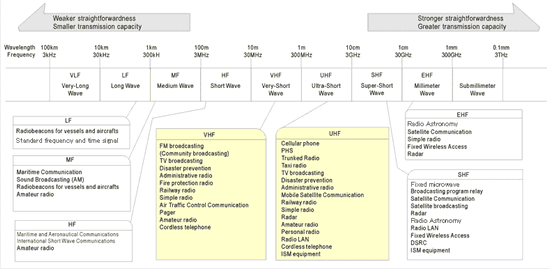Principal Uses and Characteristics of Radio Wave

- i.Very Low Frequency (VLF)
The VLF radio wave has a very long wavelength between 10km and 100km, and it propagates on the ground surface, past small mountains.
- ii.Low Frequency (LF)
The LF radio wave has a wavelength between 1km and 10km, and it propagates very far. The LF had been in use for radiotelegraphy till around 1930; however, it has not gradually been in use for the purpose as it required a large-scale antenna and transmitting device and the high frequency communication has been largely developed. The LF is partially utilized for the sound broadcasting in Europe, Africa, and some other regions, while in Japan, it is used for Loran C stations for radio navigation, navigation beacons for vessels and aircrafts, and standard frequency and time signal stations providing information on the standard frequency and time signal.
- iii.Medium Frequency (MF)
The MF radio wave has a wavelength between 100m and 1000m, and it propagates by reflecting on the E layer of the ionosphere formed at the altitude of about 100km. Because of MF dario wave's characteristics ensuring stable propagation in a long distance it is suitable for sound broadcasting. While transmission of MF radio wave requires a large-scale transmitter and antenna, only a simple type of receiver is necessary for its reception.
- iv.High Frequuency (HF)
The HF radio wave has a wavelength between 10m and 100m, and it can travel to the opposite side of the planet by repeating reflecting on the F layer of the ionosphere formed at the altitude of about 200-400km the ground surface. As it enables a long-distance communication, it is utilized for ocean vessel communication, aeronautical communication, international broadcasting, and amateur radio communications.
- v.Very High Frequency (VHF)
The VHF radio wave has a wavelength between 1m and 10m, and it propagates straightforwardly not reflecting the ionosphere, while it reaches behind mountains or buildings to an extent. As it can carry more information than the high frequency does, it is utilized for the VHF TV broadcasting, FM broadcasting, or mobile communications.
- vi.Ultra High Frequency (UHF)
The UHF radio wave has a wavelength between 10cm and 1m, and it has stronger straightforwardness than very short waves does, while it reaches behind small mountains or buildings. It is used for mobile communications as it is suitable for the transmission of a large amount of information with small antennas, transmitters and receivers. It is also used for UHF TV broadcasting.
- vii.Super High Frequency (SHF)
The SHF radio wave has a wavelength between 1cm and 10cm. Since it propagates straightforwardly, it is suitable for transmission into a specific direction. As it is suitable for transmission of a fairly large amount of information, it is used for fixed links between telephone exchanges, satellite communications, and satellite broadcasting. Furthermore, it is also used for radars.
- viii.Extremely High Frequency (EHF)
The EHF radio wave has a very short wavelength between 1mm and 10mm. It has a strong straightforwardness similarly to the light, and it is attenuated by rain or mist in a bad weather, resulting in difficulties in propagating in a long distance. Therefore, it is used for short range radiocommunications such as the simple radio communication for image transmission or fixed wireless access systems. Furthermore, the development of new types of systems such as vehicle collision prevention radars, radio LANS, etc utilizing this frequency band has been in progress.
- ix.Sub-millimeter Wave
The sub-millimeter wave has a wavelength between 0.1mm and 1mm, and it has similar characteristics to the light. Currently it is not used for radiocommunications because its transmission requires large-scale facilities and it is largely absorbed by steam. The sub-millimeter wave is used for scientific studies such as radio astronomy.
